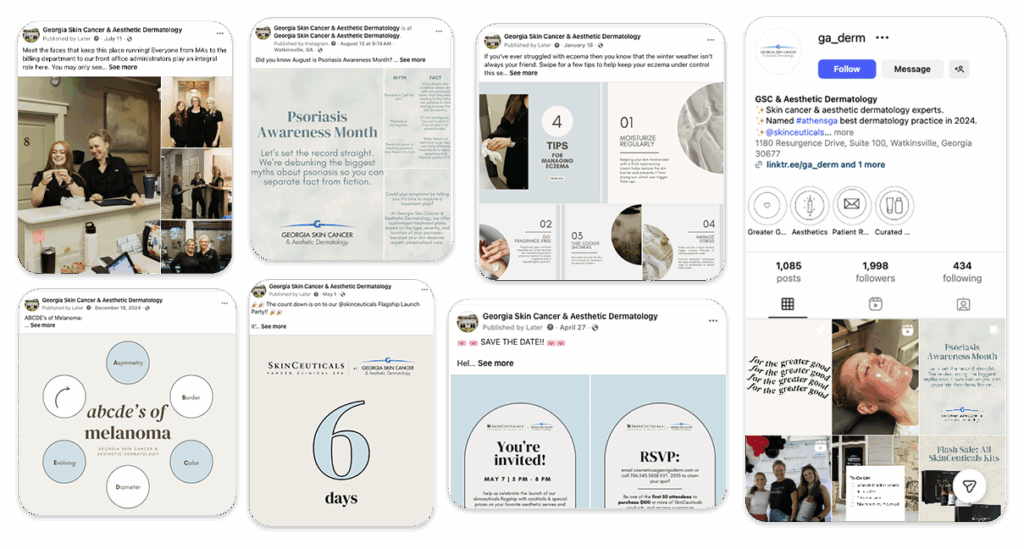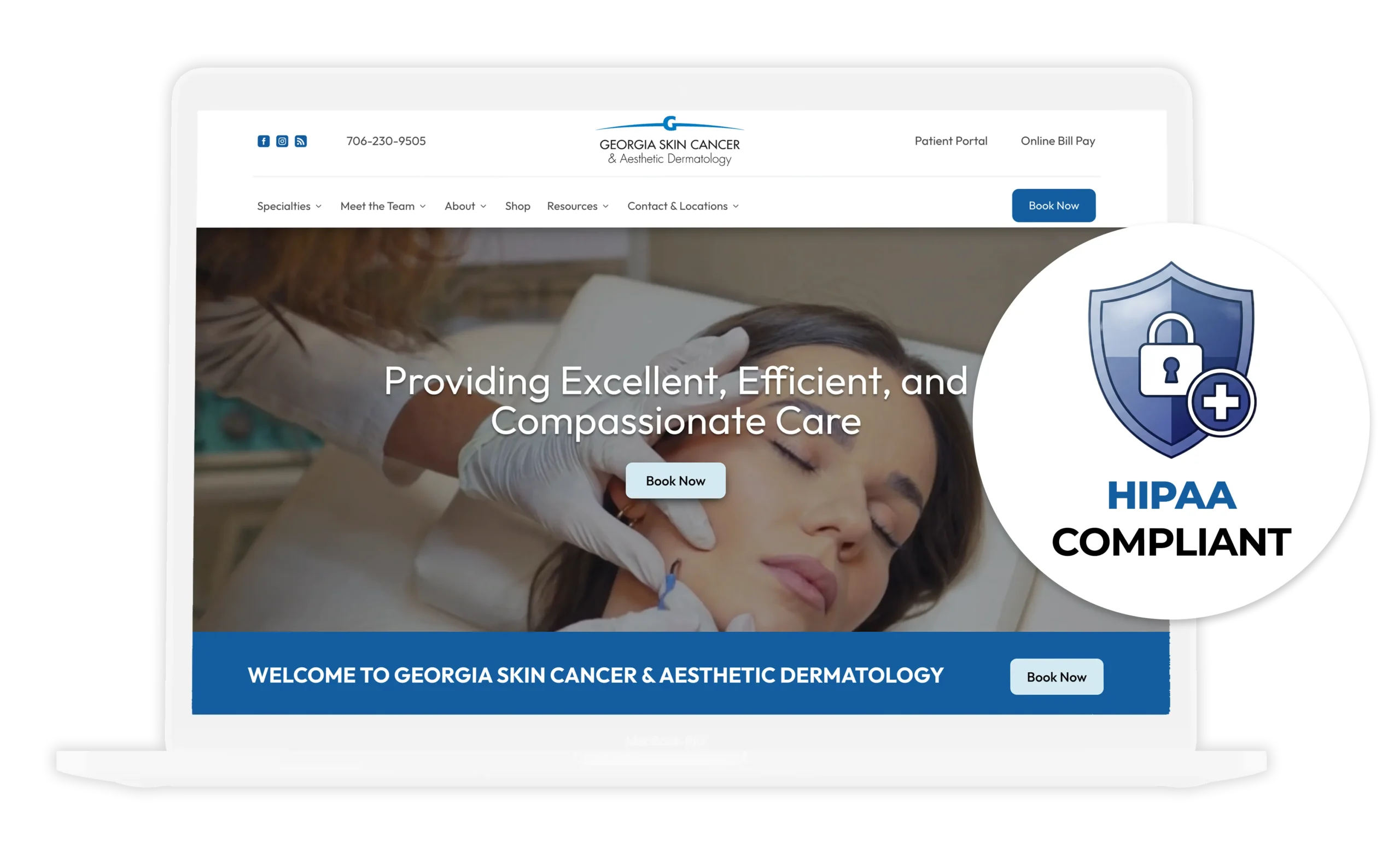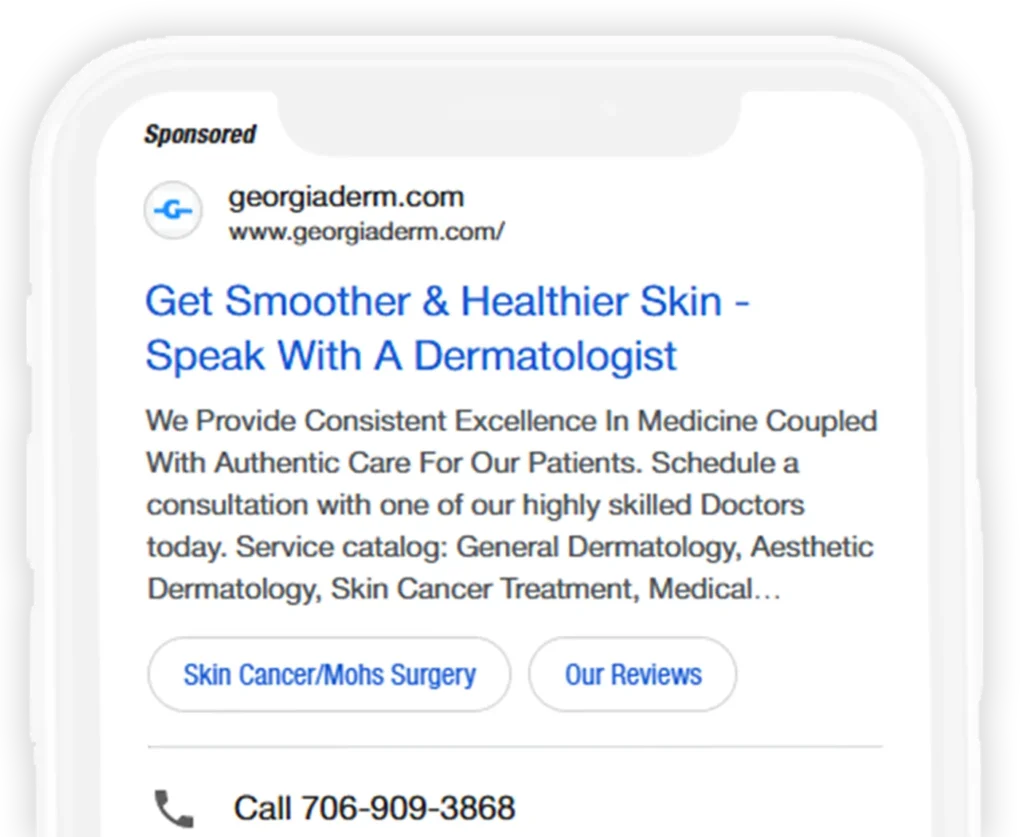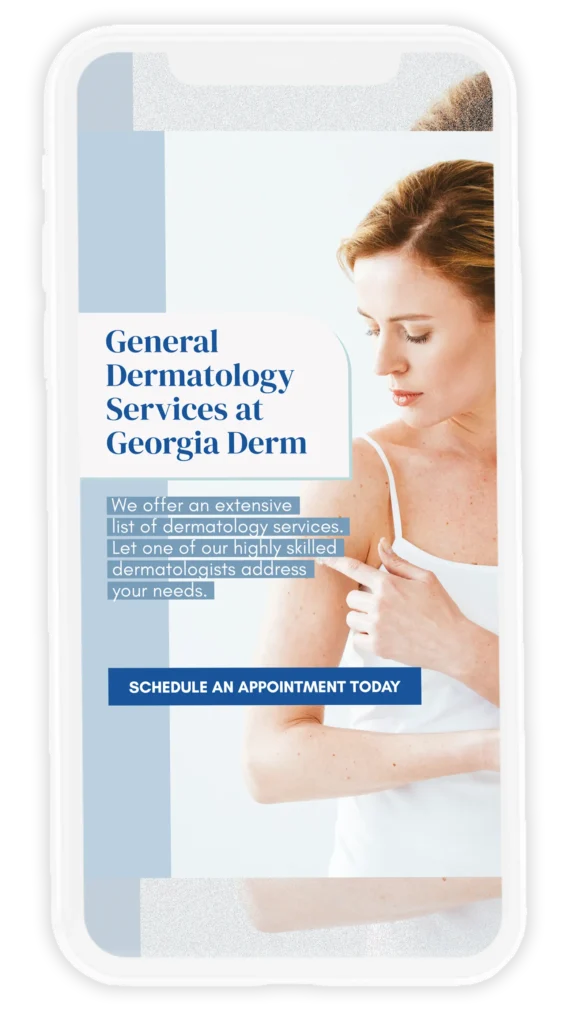The Ultimate Guide to Dermatology Marketing: Proven Digital Strategies to Attract, Convert, and Retain Patients
Running a dermatology practice requires more than clinical expertise. From managing treatment trends and patient care to overseeing front office operations, you’re balancing it all—often with little time left for marketing. But even if your results are exceptional, patients won’t know unless your practice is visible and discoverable online.
That’s where a specialized strategy comes in. At Intrepy Healthcare Marketing, we help dermatology practices—medical, cosmetic, and surgical—build customized marketing plans that drive patient acquisition, improve visibility, and communicate your unique value.
Dermatology is one of the most competitive healthcare specialties. Whether your focus is Mohs surgery, teen acne, laser resurfacing, or chronic conditions like hidradenitis suppurativa, your messaging must clearly convey what sets you apart and how you meet patient needs.
With more patients bypassing traditional referrals, your digital presence plays a critical role. You must rank for high-intent search terms like “dermatologist near me”, “Botox in [city]”, or “acne specialist”, while building trust through compelling content, patient reviews, and consistent branding. Your website, Google Business Profile, and social media platforms are now the front door to your practice.
Even with a strong physician referral network, long-term growth depends on direct-to-patient marketing. In this blog, we’ll share proven digital strategies that help dermatology practices attract the right patients, build trust, and convert interest into appointments.
TABLE OF CONTENTS
Introduction: Why Marketing for Dermatologists Demands a Specialized Strategy
Explore why traditional healthcare marketing doesn’t go far enough for dermatology practices—and what makes this field uniquely competitive, visual, and brand-driven.
- How to Build a High-Converting Dermatology Website
Turn your website into a 24/7 patient acquisition engine with conversion-focused design, mobile optimization, and streamlined calls-to-action. - Visual Branding Strategies for Dermatology Practices
Learn how consistent, compelling imagery and brand presentation drive patient trust and engagement—especially in a visually driven specialty like dermatology. - HIPAA Compliance in Dermatology Digital Marketing
Ensure your marketing efforts protect patient privacy, meet legal standards, and build long-term trust through compliant platforms and workflows. - Search Engine Optimization (SEO) for Dermatology Websites
Optimize your website structure, metadata, and technical health to rank for high-intent keywords patients are actually searching for. - Local SEO and Directory Listings for Dermatologists
Boost visibility in your geographic market by claiming, optimizing, and maintaining profiles across Google Business, directories, and local maps. - Content Marketing and Blogging Strategy for Dermatology SEO
Use blog posts, FAQs, and evergreen content to improve search rankings, educate patients, and build authority in both medical and cosmetic dermatology. - Paid Advertising Strategies for Dermatologists (Google & Social)
Design ad campaigns that drive immediate results by targeting the right procedures, demographics, and patient intent through Google Ads, Meta, and more. - Landing Page Design That Converts Website Traffic into Appointments
Turn ad clicks into booked consultations with focused, high-performing landing pages built to match patient intent. - Email Marketing for Patient Retention and Loyalty
Nurture relationships with past patients and encourage repeat visits with segmented campaigns, re-engagement flows, and personalized updates. - Social Media Strategies That Drive Dermatology Appointments
Go beyond brand awareness—use Instagram, Facebook, and TikTok to showcase results, educate followers, and drive conversions. - How to Use Marketing Data to Grow Your Dermatology Practice
Track, measure, and optimize performance across channels to make smarter marketing decisions and increase ROI.
Conclusion: A Scalable Dermatology Marketing Strategy for Long-Term Success
Wrap it all together with a streamlined, compliant, and conversion-focused approach that helps you rise above the competition and consistently attract new patients.
Introduction: Why Marketing for Dermatologists Demands a Specialized Strategy
Explore why traditional healthcare marketing doesn’t go far enough for dermatology practices—and what makes this field uniquely competitive, visual, and brand-driven.
Dermatology is a unique medical specialty with three distinct service lines, each requiring its own marketing strategy. Medical dermatology addresses skin health concerns like skin cancer screenings, eczema, and psoriasis. Cosmetic dermatology focuses on elective procedures such as Botox, dermal fillers, and laser treatments that enhance appearance. And ancillary aesthetic services—like hair restoration, body contouring, and weight management—support overall wellness and patient confidence. Each category comes with its own search intent, seasonal demand cycles, and patient motivations. In many cases, the same patient will move between all three over time, making it essential to map your marketing efforts to the full patient journey. So where should your practice begin? Based on our work with dermatology clinics nationwide, we’ve outlined the most effective digital marketing strategies to help you attract new patients, strengthen your brand, and fill your schedule—from building a high-converting website to mastering local SEO and growing your social media presence.
1. How to Build a High-Converting Dermatology Website
Turn your website into a 24/7 patient acquisition engine with conversion-focused design, mobile optimization, and streamlined calls-to-action.
Your website is more than a digital brochure—it’s often the first interaction a patient has with your dermatology practice. A high-converting website should be designed not just to inform, but to guide visitors seamlessly toward booking an appointment. To turn passive visitors into active patients, start with these three essential elements:
- Clear and consistent calls-to-action (CTAs): Every page should make it easy for patients to take the next step. Use prominent, action-oriented buttons like “Book Now,” “Schedule a Consultation,” or “Request an Appointment.”
- Mobile-first performance: Most dermatology searches happen on mobile devices. Ensure your site is fully responsive, loads in under three seconds, and provides a smooth, user-friendly experience across all screen sizes.
- Trust-building content: Showcase real patient testimonials and HIPAA-compliant before-and-after photos to provide social proof and build instant credibility. Patients want to see results—make it easy for them to visualize what you can offer.
When designed intentionally, your dermatology website becomes a powerful patient acquisition tool—active 24/7 and optimized for both search engines and human behavior.
2. Visual Branding Strategies for Dermatology Practices
Learn how consistent, compelling imagery and brand presentation drive patient trust and engagement—especially in a visually driven specialty like dermatology.
Dermatology is inherently visual—and your marketing should reflect that. While long-form content like a 500-word blog on melanoma supports SEO, it’s visual content that drives conversions. High-quality before-and-after photos, short-form videos, and branded graphics help patients envision their own results and build confidence in your expertise.
To create a strong visual identity, invest in professional photography, use HIPAA-compliant consent workflows for patient imagery, and maintain a consistent design style across all channels. From your website and social media to print materials and office signage, every visual element should reinforce the same level of professionalism and care that patients experience in person.
Branding goes far beyond your logo—it’s how your practice is perceived at every touchpoint. Introduce your providers through polished bios and brief videos to humanize your brand and build trust before the first appointment. In a specialty where results matter, visual storytelling isn’t optional—it’s a strategic asset that helps turn interest into action.
3. HIPAA Compliance in Dermatology Digital Marketing
Protect patient privacy, meet regulatory standards, and build lasting trust by using HIPAA-compliant platforms and marketing workflows.
In dermatology marketing, where before-and-after images, testimonials, and treatment details are commonly used, HIPAA compliance is not optional—it’s essential. Patients expect their personal health information to be handled with care, and any digital misstep can result in legal risks and lost trust.
To ensure compliance, start by using HIPAA-secure platforms for patient forms, email campaigns, CRMs, call tracking, and social media scheduling. Every tool that collects or transmits patient data must meet federal privacy and security standards.
When sharing before-and-after photos or testimonials, always obtain signed, HIPAA-compliant release forms and document consent with clear audit trails. Organize patient images in secure, access-controlled folders labeled by treatment type to streamline usage while maintaining privacy.
Treat all marketing content—especially when it involves names, treatment outcomes, or recognizable features—as if it contains Protected Health Information (PHI). Taking a proactive approach to HIPAA in your digital strategy not only protects your practice but positions you as a trusted, professional provider in your community
4. Search Engine Optimization (SEO) for Dermatology Websites
Optimize your website structure, metadata, and technical performance to rank for high-intent keywords your future patients are already searching for.
For most patients, the journey to your practice begins with a search engine. A query like “Botox near me” or “acne treatment in [city]” is often their first step—and if your website doesn’t appear or fails to deliver a seamless user experience, they’ll move on to a competitor.
An effective dermatology website does more than list services. It leads users through a conversion-focused journey—answering common questions, introducing providers, showcasing real patient outcomes, and guiding visitors to take action, whether that’s booking a consultation, calling your office, or downloading pre-visit instructions.
Technical SEO matters. Your website must load quickly and display perfectly on all devices—especially mobile. Over 60% of medical website traffic comes from smartphones, and both user behavior and Google rankings favor fast, responsive designs. Failing to meet those standards can directly impact both your traffic and your conversions.
Service-specific landing pages are also essential. Pages optimized for high-intent, localized keywords—like “melasma treatment in [city]” or “mole removal dermatologist near me”—help patients find exactly what they’re looking for. Each page should include structured content, clear calls-to-action, before-and-after visuals, and an FAQ section that matches real patient search queries.
Case Study: MedSpa, Roswell
79% increase in organic website traffic and a 46% reduction in cost per body treatment lead after implementing SEO and landing page optimizations.
Track performance with intent. Use tools like heatmaps, form tracking, and click-through analytics to understand where users are engaging—and where they’re dropping off. Be cautious with analytics tools that may collect Protected Health Information (PHI). Platforms like Google Analytics may pose compliance risks unless configured properly. Work with healthcare marketing experts like Intrepy to ensure your tracking infrastructure is both insightful and HIPAA-compliant.
When done right, SEO transforms your dermatology website from a passive presence into a proactive patient acquisition engine.
5. Local SEO and Directory Listings for Dermatologists
Boost visibility in your geographic market by claiming, optimizing, and maintaining profiles across Google Business, directories, and local maps.
When patients search for dermatology services, many are already prepared to schedule. The key to capturing that demand lies in understanding search intent. Someone searching “how does anti-aging cream work” is seeking education, while a user typing “acne dermatologist near me” is actively looking for care. Your local SEO strategy must align with these different stages of the patient journey.
To convert high-intent searches, optimize your service pages for location-based keywords like “microneedling for acne scars in [city]” or “dermatologist for hair loss near me.” Each page should feature a strong call-to-action, clear treatment details, and visuals or FAQs that reduce hesitation and prompt scheduling.
NAP consistency is critical—your name, address, and phone number must match exactly across all platforms, including:
- Google Business Profile
- Yelp
- Healthgrades
- RealSelf
- Vitals
Inconsistencies confuse search engines and lower your ranking, potentially costing you high-converting leads.
Enhance your directory profiles with updated business hours, high-quality photos, service-specific descriptions, provider bios, and highlights from patient reviews. Actively requesting and responding to reviews signals relevance and builds trust—two major factors in local search performance.
On the technical side, implement local schema markup on your website. This structured data helps search engines understand your location, services, and practice details—boosting your chances of appearing in Google’s local 3-pack and map results.
When done right, local SEO places your dermatology practice in front of the right patients, in the right place, at exactly the right time.
6. Content Marketing and Blogging Strategy for Dermatology SEO
Use blog posts, FAQs, and evergreen content to improve search rankings, educate patients, and build authority in both medical and cosmetic dermatology.
An effective dermatology content strategy goes beyond general education—it aligns directly with the questions real patients are searching for. Focus your blog and content efforts on long-tail, intent-driven keywords that reflect specific patient concerns and seasonal trends. Examples include:
- “How to treat rosacea in winter”
- “Should I worry about a new mole?”
- “Melanoma symptoms pictures”
- “Is microneedling safe for darker skin tones?”
These highly targeted topics not only improve your site’s SEO but also position your practice as an authoritative, helpful resource.
Content marketing for dermatology is most effective when it supports every stage of the patient journey—from awareness to decision-making. Educational blog posts can introduce your expertise, FAQs can clarify expectations, and evergreen content (like post-treatment care guides or skincare routines by condition) keeps patients coming back.
Avoid outdated SEO tactics like keyword stuffing. Instead, focus on creating structured, informative, and easy-to-navigate content that search engines can crawl—and patients can trust. Include internal links, schema markup, clear headings, and natural phrasing that mirrors how patients ask questions.
A consistent content strategy builds topical authority over time, helping you rank higher in search, answer patient concerns before they call, and convert more website visitors into scheduled appointments.
7. Paid Advertising Strategies for Dermatologists (Google & Social)
Design ad campaigns that drive immediate results by targeting the right procedures, demographics, and patient intent through Google Ads, Meta, and more.
While SEO builds long-term visibility, paid advertising provides instant results—especially for high-demand, high-margin services in cosmetic and elective dermatology. Platforms like Google Ads, Instagram, and Facebook are powerful tools for reaching patients actively searching for procedures like Botox, microneedling, or laser resurfacing in your area.
To run effective campaigns, start by defining clear objectives. Are you promoting a limited-time filler special? Looking to grow your body contouring patient base? Trying to attract more medical dermatology consults? Each campaign should be structured around one specific goal.
Segment your ad groups and match them to targeted landing pages. This improves relevance, quality scores, and conversion rates. For example, an ad for “lip filler specials” should lead directly to a page with lip enhancement details, pricing, provider info, and a booking CTA—not a generic homepage.
Use geo-targeting and demographic filters to refine your audience. Highlight benefits that resonate with patient concerns—such as natural-looking results, board-certified providers, or fast recovery times. Paid ads also allow for A/B testing across creatives, headlines, and CTA buttons to continuously improve performance.
Without proper targeting and optimization, paid advertising can drain your budget. But with a focused strategy, dermatology practices can use digital ads to fill appointment slots, boost seasonal campaigns, and stay competitive in a crowded local market.
8. Landing Page Design That Converts Website Traffic into Appointments
Turn ad clicks into booked consultations with focused, high-performing landing pages built to match patient intent.
In digital advertising, the destination matters as much as the message. Sending users to a generic homepage often results in drop-offs. Instead, high-performing dermatology campaigns direct traffic to procedure-specific landing pages that are tightly aligned with the ad’s content and patient intent.
To convert effectively, each landing page should include:
- A clear headline that mirrors the ad’s promise
- Fast load speed and mobile-first design
- Trust-building elements such as patient testimonials, before-and-after photos, and provider bios
- A strong call-to-action like “Book Now” or “Request a Consultation” placed above the fold
These pages should reassure the patient, answer immediate questions, and make the next step easy.
Platforms like Google Ads, Facebook, and Instagram are especially effective for driving traffic to cosmetic dermatology landing pages. Enhance performance with retargeting campaigns to re-engage past visitors and use geofencing ads to target users near competing clinics.
To ensure every dollar delivers results, implement call tracking and attribution modeling. These tools reveal which campaigns generate actual appointments and help you optimize future ad spend.
When thoughtfully designed, landing pages don’t just absorb traffic—they convert it into real, measurable practice growth.
9. Email Marketing for Patient Retention and Loyalty
Nurture relationships with past patients and encourage repeat visits with segmented campaigns, re-engagement flows, and personalized updates.
Patients who trust your practice once are likely to return—if you stay engaged. That’s where email marketing becomes an essential retention tool. With the right strategy, email campaigns can encourage seasonal follow-ups, promote new services, and build loyalty that spans years.
Start by segmenting your email lists through your practice management system. For example, patients who received Botox or fillers may be due for a refresh, while those treated for skin cancer can benefit from educational content on mole monitoring, sun safety, or annual screening reminders.
Your emails don’t need to be flashy—they need to be timely, relevant, and actionable. Share updates about new procedures, promote seasonal skincare packages, or offer expert insights through blog roundups, skincare tips, or Q&A features from your providers. Every email should include a clear CTA that drives patients back to your website, booking tool, or contact form.
Always use HIPAA-compliant email marketing platforms, especially when automating follow-ups or collecting patient data through forms. With secure tools and a patient-centered content strategy, email marketing can do more than fill appointment slots—it can turn satisfied patients into loyal brand advocates.
10. Social Media Strategies That Drive Dermatology Appointments
Go beyond brand awareness—use Instagram, Facebook, and TikTok to showcase results, educate followers, and drive conversions.
Your dermatology practice is a content goldmine. Every successful skin transformation, provider insight, and behind-the-scenes moment is an opportunity to create compelling social media content that educates, engages, and ultimately drives appointments.
However, success on social media depends on platform-specific strategies. Instagram and TikTok are ideal for visual storytelling—use reels, carousels, and trending formats to highlight cosmetic procedures, patient journeys, and provider personalities. For medical dermatology and community outreach, platforms like Facebook and LinkedIn offer better reach for educational posts, practice news, and professional updates.
One of our clients, Facial Plastic Surgery Clinic in Atlanta, saw a 399% increase in YouTube watch time after implementing a strategic content program tailored to their audience.
“Intrepy helped us develop our social media program, including Facebook, X, Instagram, and Pinterest. Their team did a great job of helping us with content and made posting easy for us. The increase in traffic and followers was substantial and steadily growing. I certainly recommend their work.”
— Facial Plastic Surgery Clinic, Atlanta
Focus on connection, not just content. Use short-form videos to introduce your providers, feature real patient testimonials, and share quick skincare tips or treatment previews that establish your team as a trusted authority. Authentic storytelling humanizes your brand and strengthens the patient-provider relationship before the first visit.
Consistency and engagement build social proof. Every comment, share, or like increases your visibility and signals credibility to prospective patients. The more intentionally you show up online, the more likely your ideal audience is to remember—and choose—your practice when it matters most.
11. How to Use Marketing Data to Grow Your Dermatology Practice
Track, measure, and optimize performance across channels to make smarter marketing decisions and increase ROI.
Top-performing dermatology practices approach marketing like a science—not a guessing game. In a competitive landscape, data-driven decision-making is essential for attracting high-value patients, improving efficiency, and maximizing return on investment (ROI).
Your marketing analytics should go beyond basic metrics. A well-designed dashboard should answer critical questions:
- Which keywords drive qualified patient inquiries?
- Which blog posts or service pages lead to appointment bookings?
- What is your cost per lead across Google Ads, Instagram, and email campaigns?
- Are users converting more from mobile or desktop?
By identifying what works (and what doesn’t), your team can reallocate budget, improve ad targeting, and refine content to better align with patient behavior and search intent.
Partners like Intrepy Healthcare Marketing provide real-time dashboards, monthly strategy reviews, and actionable insights—so you’re not making decisions in the dark. With accurate data at your fingertips, you can confidently scale successful campaigns, eliminate underperforming tactics, and stay ahead of competitors in your market.
When your marketing strategy is grounded in measurable outcomes, growth becomes strategic—not accidental.
Conclusion: A Scalable Dermatology Marketing Strategy for Long-Term Success
Wrap it all together with a streamlined, compliant, and conversion-focused approach that helps you rise above the competition and consistently attract new patients.
As a dermatologist, your focus should be on delivering excellent care—not decoding SEO updates or managing ad campaigns. That’s where Intrepy Healthcare Marketing comes in. We specialize in dermatology marketing strategies that are compliant, conversion-focused, and built specifically for the demands of your specialty.
We understand what makes dermatology unique: from the visual nature of cosmetic treatments to the strict privacy standards required for HIPAA compliance. Whether you’re promoting acne care, skin cancer screenings, or advanced aesthetic services, we provide integrated solutions that connect each part of your marketing ecosystem—SEO, paid advertising, website optimization, social media strategy, and patient retention funnels.
Our goal isn’t vanity metrics—it’s meaningful growth. That means more high-value patients, stronger retention, and marketing strategies that align with your clinical and business goals.
Whether you’re starting fresh or improving your current approach, we offer everything you need in Dermatology Marketing:
- Website Design and Development
- Local SEO
- Google Ads
- Landing page optimization
- Social media engagement
- Review generation and reputation management
About The Authors
By Tomi Barton, Chief Marketing Officer, Intrepy Healthcare Marketing
Tomi is the CMO at Intrepy Healthcare Marketing, a leading medical marketing agency, specializing in dermatology, plastic surgery, medspa, and other specialty care practices. With over 20 years of experience in healthcare digital growth strategies, she has helped hundreds of physicians increase new patient volume and brand authority through SEO, content strategy, and targeted patient advertising.
Co-authored by Megan Patton, Healthcare Content Development Specialist
Megan is an experienced healthcare content strategist and writer at Intrepy Healthcare Marketing. She specializes in creating educational, high-converting SEO content for medical practices and brings a deep understanding of patient search and funnel behavior.











